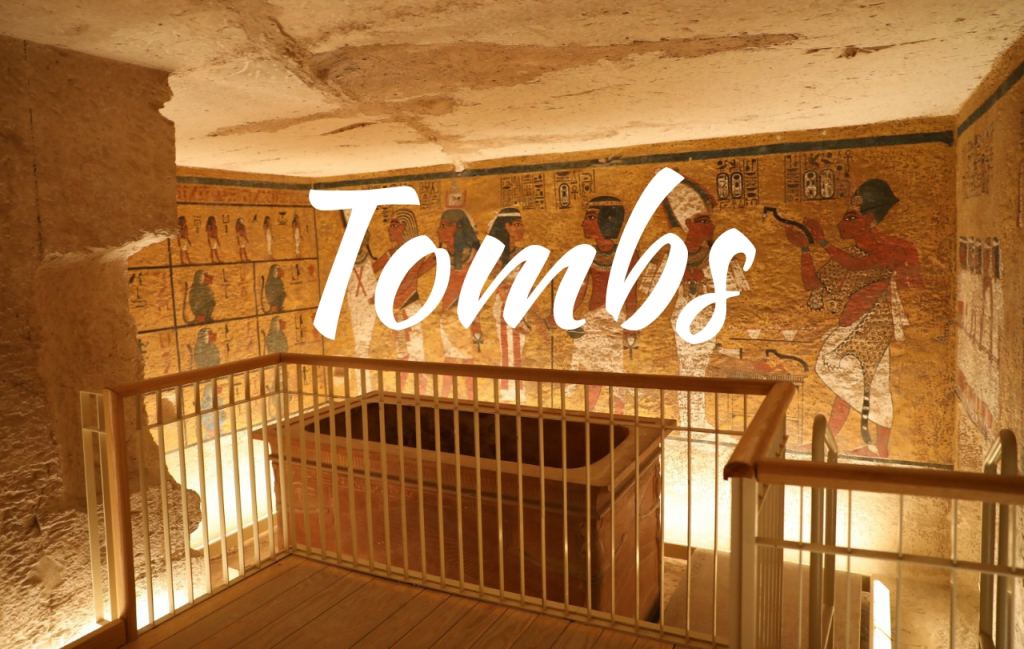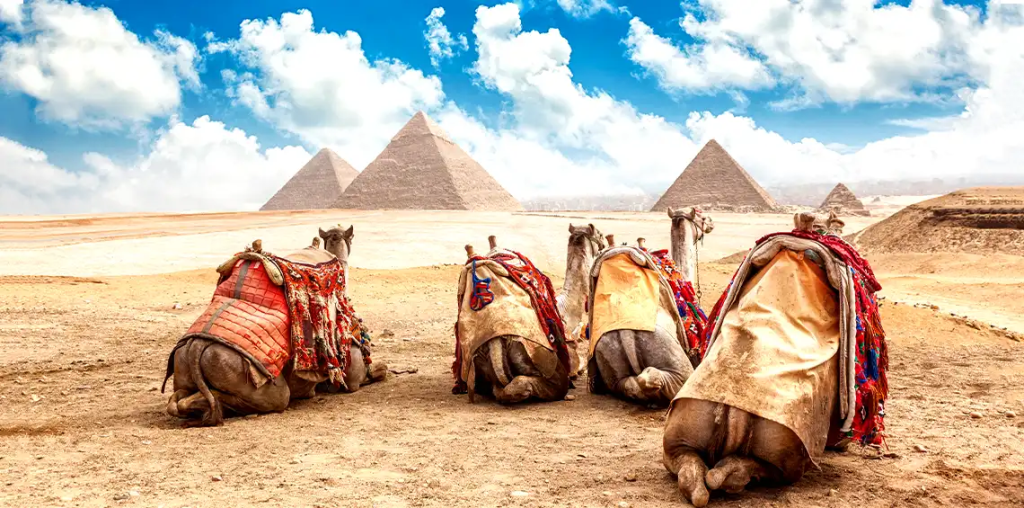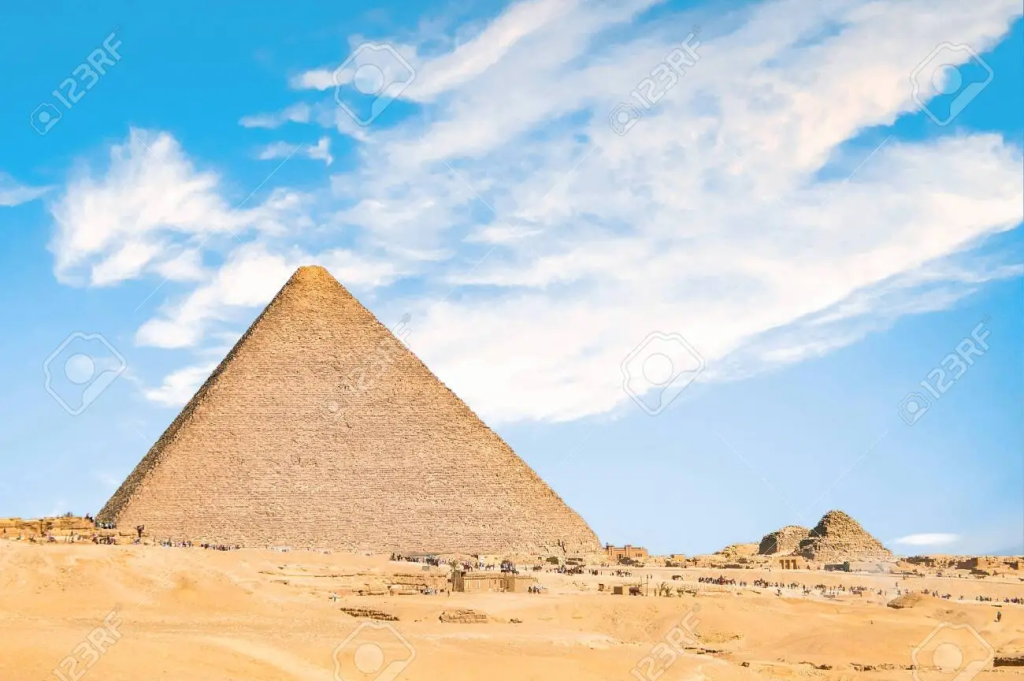
The Astonishing Ancient Egyptian Tombs
The ancient Egyptian tombs stand as living testaments to the incredible artistic mastery and architectural brilliance achieved by the Egyptian civilization. Within these tombs lie a rich tapestry of engravings, drawings, and writings that eloquently tell the stories and poems of the lives they memorialize. An embodiment of the belief in the continuity of life beyond death, the tombs were adorned with items such as food, drinks, clothing, gold, and personal possessions, as if the departed were embarking on an eternal journey.The grandeur of ancient Egyptian tombs extends to the iconic pyramids that served as the final resting places of kings and queens. Yet, these monumental structures were not immune to the hands of tomb raiders during Egypt’s Old Kingdom and Middle Kingdom eras. Subsequently, a shift occurred, leading to the creation of concealed tombs, and this is why new discoveries continue to emerge.
Our collection of articles on this page is a treasure trove of insights into the renowned tombs of Egypt. Since 1985, Egypt Tours Expert has been your guide to delving into the mysteries, history, and artistic splendors concealed within these ancient tombs. Our team comprises exceptional tour guides, operators, drivers, and dedicated travel experts who ensure seamless arrangements, from accommodations to Nile River cruises and transportation, tailored to your preferences. Our unwavering commitment to impeccable booking procedures and stringent safety guidelines has earned us numerous accolades, including being Certified By Tripadvisor as the Travelers’ Choice of 2022 in Egypt. We’ve also been recognized as the Winner of Luxury Lifestyle Awards in the Best Luxury Travel Agency category for 2020. These accolades reflect our dedication to providing you with unparalleled experiences.

The Valley of the Kings, a UNESCO World Heritage Site, is a sacred resting place for some of Egypt’s most powerful rulers. Nestled within the desert hills, the valley houses tombs adorned with intricate hieroglyphs and rich treasures. Our guided tour offers you the chance to explore this archaeological marvel and discover the remnants of a civilization that once flourished along the Nile View Tour Details

The Catacombs of Kom El Shuqqafa
The Catacombs of Kom El Shuqqafa, also known as the “Mound of Shards,” are a fascinating underground burial complex that date back to the Roman period in Alexandria. This necropolis is a unique testament to the convergence of Greek, Roman, and Egyptian cultures, evident in its art, architecture, and rituals. Our guided tour offers you the opportunity to step back in time, explore the underground chambers, and uncover the stories of the past that lie within the catacombs’ depths View Tour Details

The Valley of the Queens, nestled on the west bank of the Nile, is a testament to the royal women of ancient Egypt. This serene necropolis is home to beautifully adorned tombs, intricate reliefs, and stories that offer insights into the lives of queens and noblewomen. Our guided tour allows you to step into this sacred space and honor the memory of the women who played significant roles in Egypt’s history View Tour Details

The City of the Dead, known as Al Qarafa, is a vast necropolis that serves as the final resting place for countless generations of Cairenes. This sprawling complex of mausoleums and tombs reveals the intersection of life and death, where families visit their ancestors, and communities thrive amidst the gravestones. Our guided tour provides insight into the rich history, cultural practices, and unique coexistence within this unconventional urban space View Tour Details

The Valley of the Nobles, situated on Luxor’s west bank, offers a glimpse into the lives of the people who worked on the tombs in the Valley of the Kings and the Valley of the Queens. This residential area boasts tombs, vibrant reliefs, and remnants of the daily lives of ancient Egyptian craftsmen and their families. Our guided tour allows you to walk in their footsteps and immerse yourself in their stories View Tour Details
Be a Witness on the Egyptian Tombs
Embark on an extraordinary journey through the land of the Pharaohs with our Egypt Private Tours and Nile River cruises. Immerse yourself in an endless panorama of remarkable ancient tombs and treasures that have withstood the test of time. As you sail along the majestic Nile River, you’ll be transported through history, unraveling the stories enshrined within tombs of all shapes and sizes.
Embark on an unforgettable 4-day tour package to Cairo and Abu Simbel, where ancient wonders and majestic temples await. Explore the iconic sites of Cairo, including the pyramids of Giza and the Egyptian Museum, before journeying to Abu Simbel to witness the breathtaking temples of Ramses II and Nefertari. With our carefully curated itinerary, knowledgeable guides, and inclusive services, this tour offers a compact yet immersive experience of Egypt’s rich history. Discover the secrets of the pharaohs, marvel at awe-inspiring architecture, and create lasting memories View Tour Details

5 Days Cairo and Alexandria Tour Package
Embark on a 5-day journey through Egypt’s most fascinating cities, Cairo and Alexandria. From the grand pyramids and ancient temples to the coastal beauty and cultural landmarks, this tour package is designed to showcase the best of both worlds. With expert guides, comfortable accommodations, and convenient transportation, you’ll have an immersive and hassle-free experience. Join us on this captivating adventure and create memories that will last a lifetime View Tour Details

6 Days Cairo, Luxor, Aswan & Abu Simbel Package
Embark on an extraordinary 6-day journey through the heart of ancient Egypt with our Cairo, Luxor, Aswan & Abu Simbel package. Begin your adventure in Cairo, where you’ll explore the iconic pyramids and delve into the treasures of the Egyptian Museum. Continue to Luxor and Aswan, where you’ll witness the grand temples along the Nile River, and conclude your tour with a visit to the awe-inspiring temples of Abu Simbel. With expert guides, comfortable accommodations, and hassle-free transportation, this package offers a comprehensive exploration of Egypt’s historic sites. Join us on this incredible journey and unlock the secrets of the pharaohs View Tour Details

7 Days Cairo, Luxor & Alexandria Tour
Experience the best of Egypt’s cultural and coastal attractions with our 7-day Cairo, Luxor & Hurghada holiday. Begin your journey in Cairo, where you’ll discover the iconic Pyramids of Giza, explore the ancient artifacts at the Egyptian Museum, and immerse yourself in the vibrant atmosphere of Egypt’s capital. Then, travel to Luxor, often referred to as the world’s greatest open-air museum, where you’ll explore magnificent temples, tombs, and archaeological sites. Finally, unwind in the idyllic beach destination of Hurghada, known for its pristine beaches and vibrant marine life View Tour Details

8 Days Cairo, Abu Simbel, Luxor & Hurghada
Experience the best of Egypt’s ancient wonders and coastal charm on our 8-day Cairo, Abu Simbel, Luxor & Hurghada tour. From the vibrant streets of Cairo to the awe-inspiring temples of Abu Simbel and the captivating historical sites of Luxor, this itinerary offers a perfect blend of cultural exploration and relaxation. Conclude your journey in the picturesque beachside town of Hurghada, where you can unwind and soak up the sun. Join us for an unforgettable adventure through Egypt’s rich heritage and natural beauty View Tour Details

9 Days Alexandria, Cairo & Sharm El Sheikh Holiday
Experience the perfect combination of history and relaxation with our 9-day Alexandria, Cairo & Sharm El Sheikh Holiday. Begin your journey in Alexandria, where you’ll discover the Greco-Roman ruins and the impressive Bibliotheca Alexandrina. Continue to Cairo to explore the iconic pyramids, bustling markets, and historic landmarks. Finally, head to the idyllic coastal paradise of Sharm El Sheikh, where you can indulge in snorkeling, diving, or simply bask in the sun on beautiful beaches. This itinerary is designed to provide a comprehensive and memorable vacation in Egypt View Tour Details
Ancient Egyptian Tombs FAQs
- What are ancient Egyptian tombs? Ancient Egyptian tombs were burial structures constructed to house the remains of the deceased and provide them with provisions and offerings for the afterlife.
- Why were tombs important in ancient Egyptian culture? Tombs held immense significance in ancient Egyptian culture because they were believed to be the final resting places for the deceased’s body and soul, ensuring a successful transition to the afterlife.
- What were the different types of ancient Egyptian tombs? Ancient Egyptian tombs included mastabas, rock-cut tombs, pyramids, and underground catacombs. These tombs varied in complexity and design.
- What was the purpose of the pyramids as tombs? The pyramids were monumental tombs built for pharaohs and elite individuals. They were designed to protect the body and soul of the deceased and serve as platforms for ascension to the heavens.
- What are mastabas? Mastabas were rectangular flat-topped tombs made of mudbrick or stone. They were commonly used during the Early Dynastic and Old Kingdom periods.
- Why did ancient Egyptians decorate tombs with artwork? Artwork in tombs, such as paintings and carvings, depicted scenes from the deceased’s life, religious rituals, and offerings. These images were believed to assist the deceased in the afterlife.
- What is unique about rock-cut tombs? Rock-cut tombs were carved directly into cliffs or rock formations. They often included elaborate chambers, passages, and decorations, especially during the New Kingdom period.
- What were catacombs used for in ancient Egypt? Catacombs were used as burial places for multiple individuals, such as family members or members of a specific community or profession.
- Where were ancient Egyptian tombs typically located? Tombs were often located on the west bank of the Nile River, symbolizing the realm of the setting sun and the entrance to the afterlife.
- What were canopic jars used for in tombs? Canopic jars were used to store the organs of the deceased after mummification. Each jar was associated with a specific deity and organ.
- What is the significance of the Valley of the Kings? The Valley of the Kings is a burial site located on the west bank of the Nile near Luxor. It contains the tombs of many pharaohs and high-ranking officials.
- What is the Book of the Dead in relation to ancient Egyptian tombs? The Book of the Dead was a collection of spells, prayers, and instructions meant to guide the deceased through the afterlife. Copies of this text were often placed in tombs.
- Were tombs ever reused in ancient Egypt? Yes, in some cases, tombs were reused for subsequent burials, and older burials might be moved to make room for new ones.
- How were ancient Egyptian tombs protected and secured? Tombs were often sealed with large stone blocks, and some tombs had hidden or booby-trapped entrances to deter tomb robbers.
- Did ancient Egyptian tombs have architectural features beyond burial chambers? Yes, tombs often included chapels, offering halls, and rooms for funerary rituals and ceremonies.
- Why are the tomb paintings important for understanding ancient Egyptian life? Tomb paintings provide insights into the daily life, religious beliefs, social customs, and activities of ancient Egyptians.
- Did only pharaohs and elite individuals have tombs? While pharaohs and the elite had grand tombs, individuals from various social strata had tombs that ranged in size and complexity.
- What have modern archaeologists learned from studying ancient Egyptian tombs? Archaeological studies of tombs have revealed details about ancient Egyptian culture, religious practices, burial customs, and the evolution of architecture.
- Can visitors explore ancient Egyptian tombs today? Yes, many ancient Egyptian tombs are open to visitors, allowing them to experience the art, architecture, and religious significance of these historical sites.
- How can visitors show respect when visiting ancient Egyptian tombs? Visitors should follow any rules or guidelines set by site authorities, avoid touching the artwork, and act respectfully to preserve the tombs and their historical significance.


